Organizational Structure, Dynamics, and Culture Analysis: BWH Report
VerifiedAdded on 2022/11/29
|7
|1584
|174
Report
AI Summary
This report examines the organizational structure, dynamics, and culture of Brigham and Women's Hospital (BWH), with a specific focus on the Shapiro Cardiovascular Center and its physicians. It begins by outlining the hospital's structure, including the role of the Brigham and Women’s Physician Organization (BWPO) and the implications of the organizational culture. The report then analyzes the challenges faced by the Shapiro Cardiovascular Center, such as space limitations and physician concerns regarding a new practice model. Motivational theories, particularly the Expectancy Theory of Performance, are applied to assess the situation, and the report recommends four action steps to improve physician motivation, including enhancing leadership styles, implementing appraisal and reward systems, minimizing disparities, and engaging support from board governance. The report provides a comprehensive analysis of organizational challenges and offers practical recommendations for fostering a positive and productive environment for physicians at BWH.
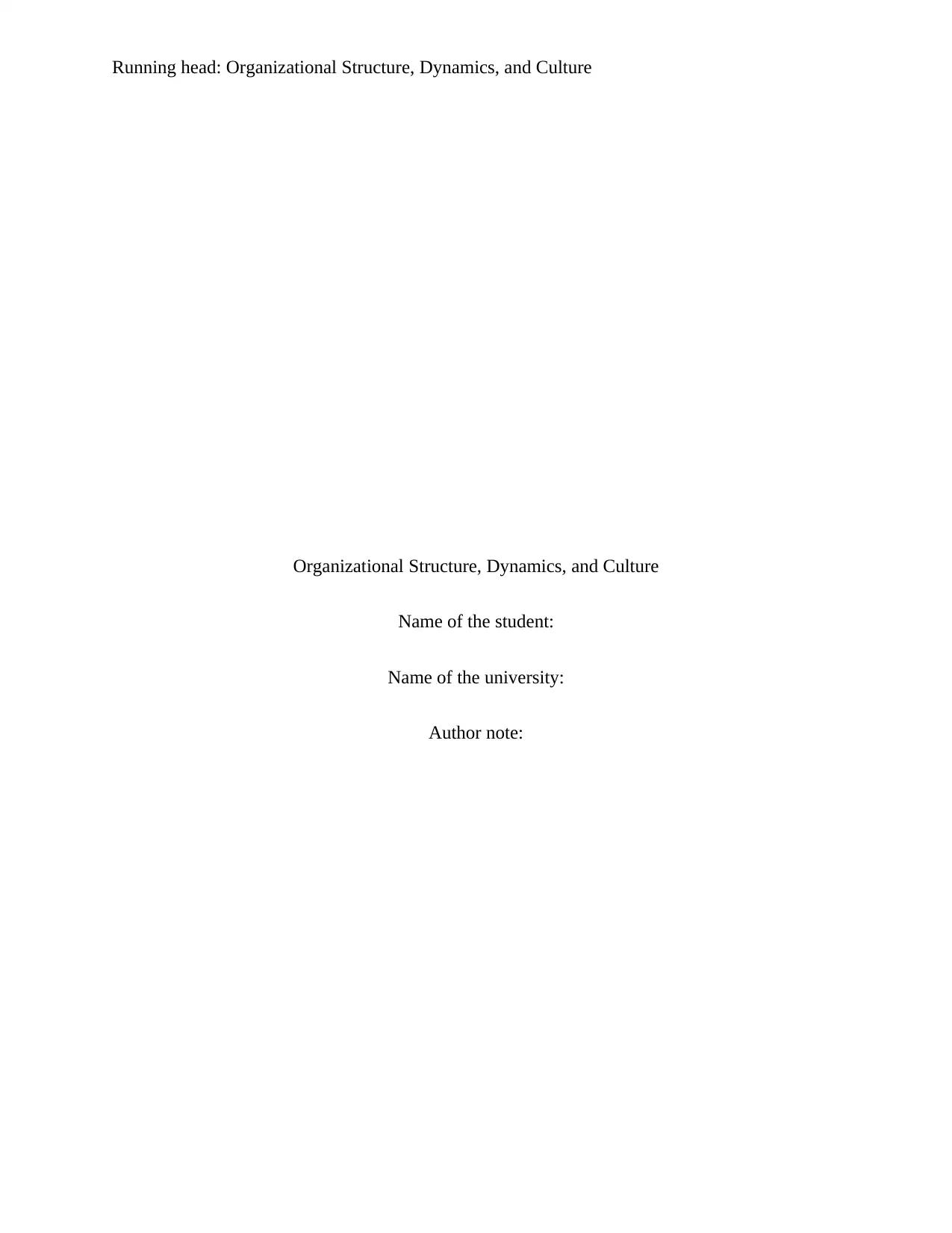
Running head: Organizational Structure, Dynamics, and Culture
Organizational Structure, Dynamics, and Culture
Name of the student:
Name of the university:
Author note:
Organizational Structure, Dynamics, and Culture
Name of the student:
Name of the university:
Author note:
Paraphrase This Document
Need a fresh take? Get an instant paraphrase of this document with our AI Paraphraser
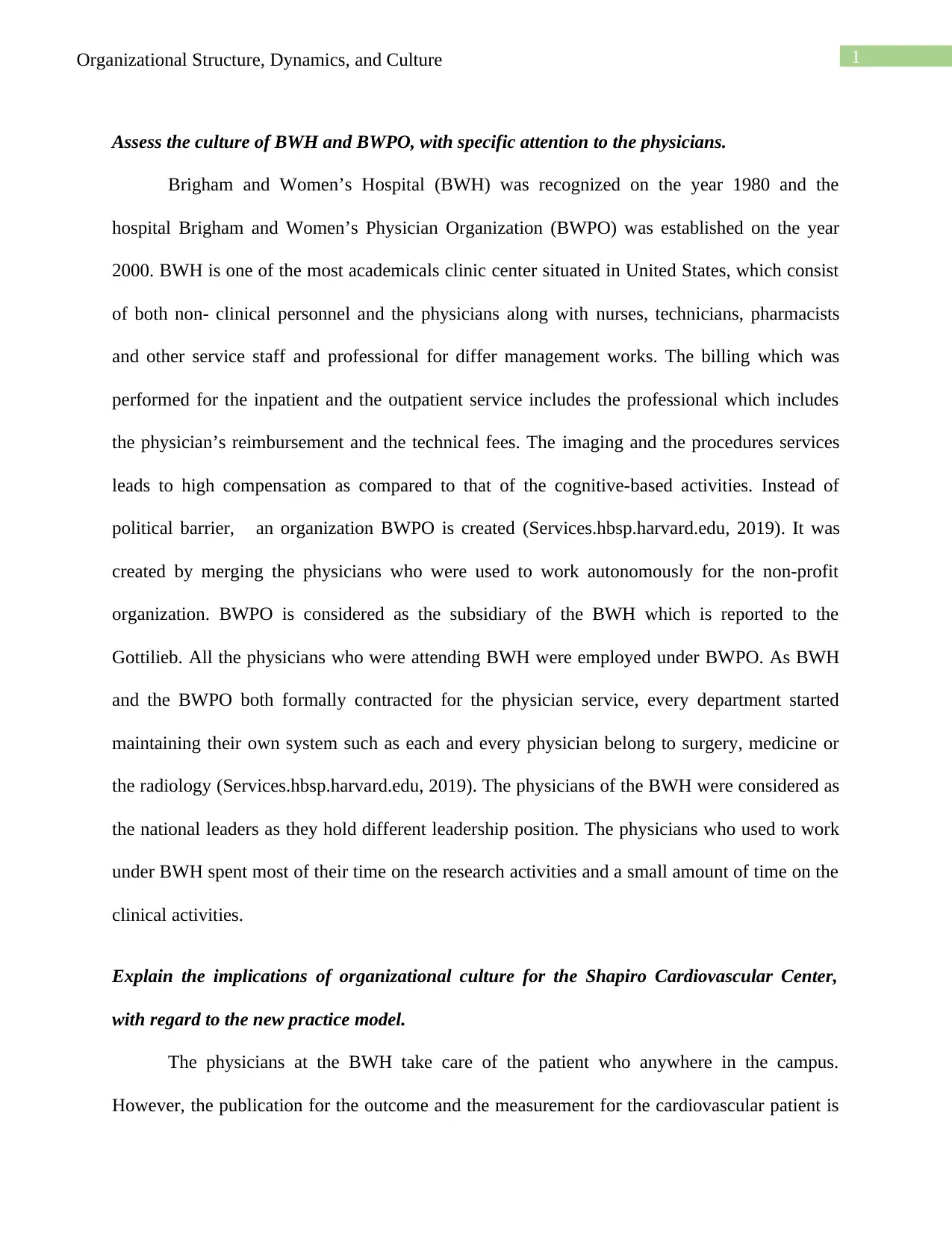
1Organizational Structure, Dynamics, and Culture
Assess the culture of BWH and BWPO, with specific attention to the physicians.
Brigham and Women’s Hospital (BWH) was recognized on the year 1980 and the
hospital Brigham and Women’s Physician Organization (BWPO) was established on the year
2000. BWH is one of the most academicals clinic center situated in United States, which consist
of both non- clinical personnel and the physicians along with nurses, technicians, pharmacists
and other service staff and professional for differ management works. The billing which was
performed for the inpatient and the outpatient service includes the professional which includes
the physician’s reimbursement and the technical fees. The imaging and the procedures services
leads to high compensation as compared to that of the cognitive-based activities. Instead of
political barrier, an organization BWPO is created (Services.hbsp.harvard.edu, 2019). It was
created by merging the physicians who were used to work autonomously for the non-profit
organization. BWPO is considered as the subsidiary of the BWH which is reported to the
Gottilieb. All the physicians who were attending BWH were employed under BWPO. As BWH
and the BWPO both formally contracted for the physician service, every department started
maintaining their own system such as each and every physician belong to surgery, medicine or
the radiology (Services.hbsp.harvard.edu, 2019). The physicians of the BWH were considered as
the national leaders as they hold different leadership position. The physicians who used to work
under BWH spent most of their time on the research activities and a small amount of time on the
clinical activities.
Explain the implications of organizational culture for the Shapiro Cardiovascular Center,
with regard to the new practice model.
The physicians at the BWH take care of the patient who anywhere in the campus.
However, the publication for the outcome and the measurement for the cardiovascular patient is
Assess the culture of BWH and BWPO, with specific attention to the physicians.
Brigham and Women’s Hospital (BWH) was recognized on the year 1980 and the
hospital Brigham and Women’s Physician Organization (BWPO) was established on the year
2000. BWH is one of the most academicals clinic center situated in United States, which consist
of both non- clinical personnel and the physicians along with nurses, technicians, pharmacists
and other service staff and professional for differ management works. The billing which was
performed for the inpatient and the outpatient service includes the professional which includes
the physician’s reimbursement and the technical fees. The imaging and the procedures services
leads to high compensation as compared to that of the cognitive-based activities. Instead of
political barrier, an organization BWPO is created (Services.hbsp.harvard.edu, 2019). It was
created by merging the physicians who were used to work autonomously for the non-profit
organization. BWPO is considered as the subsidiary of the BWH which is reported to the
Gottilieb. All the physicians who were attending BWH were employed under BWPO. As BWH
and the BWPO both formally contracted for the physician service, every department started
maintaining their own system such as each and every physician belong to surgery, medicine or
the radiology (Services.hbsp.harvard.edu, 2019). The physicians of the BWH were considered as
the national leaders as they hold different leadership position. The physicians who used to work
under BWH spent most of their time on the research activities and a small amount of time on the
clinical activities.
Explain the implications of organizational culture for the Shapiro Cardiovascular Center,
with regard to the new practice model.
The physicians at the BWH take care of the patient who anywhere in the campus.
However, the publication for the outcome and the measurement for the cardiovascular patient is
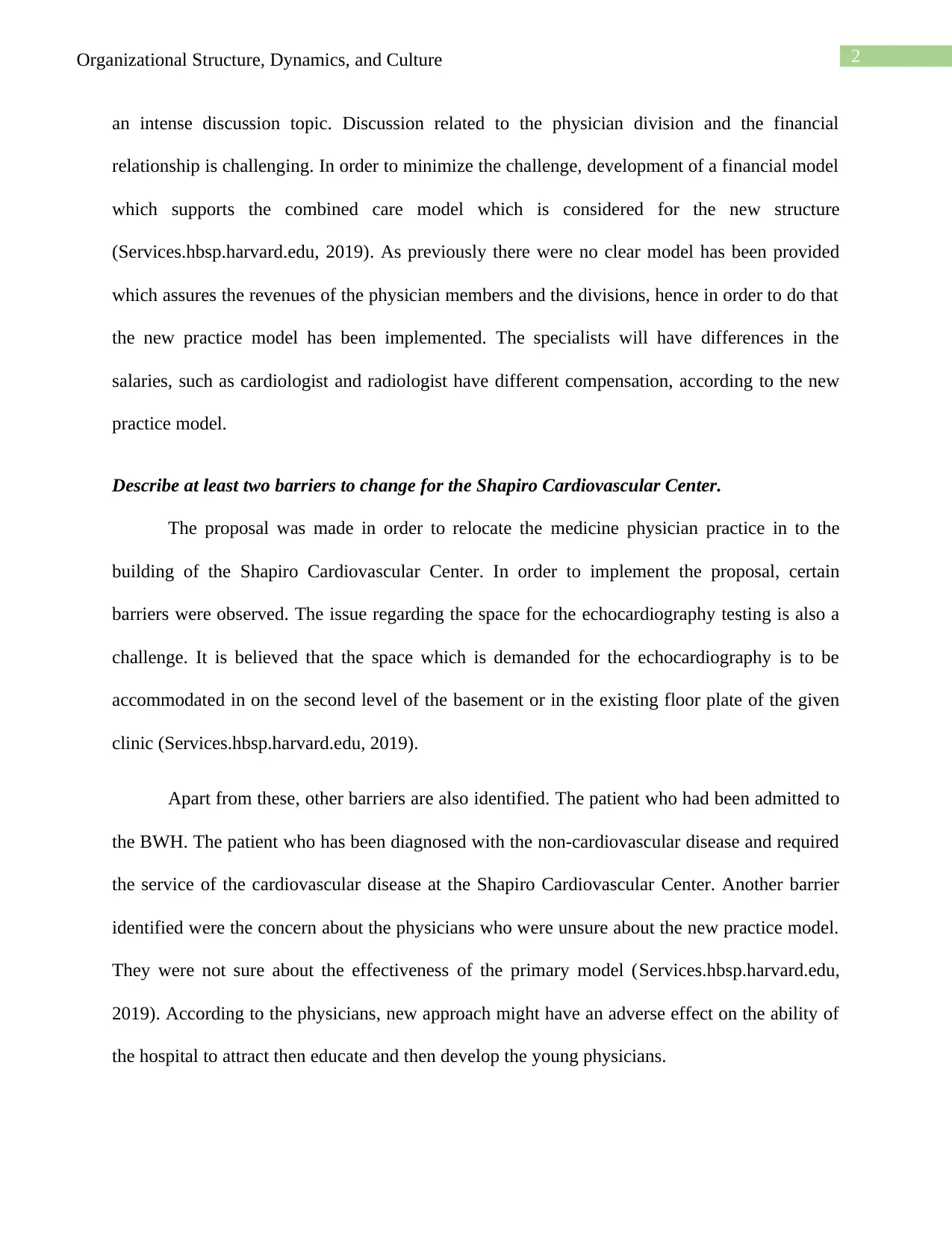
2Organizational Structure, Dynamics, and Culture
an intense discussion topic. Discussion related to the physician division and the financial
relationship is challenging. In order to minimize the challenge, development of a financial model
which supports the combined care model which is considered for the new structure
(Services.hbsp.harvard.edu, 2019). As previously there were no clear model has been provided
which assures the revenues of the physician members and the divisions, hence in order to do that
the new practice model has been implemented. The specialists will have differences in the
salaries, such as cardiologist and radiologist have different compensation, according to the new
practice model.
Describe at least two barriers to change for the Shapiro Cardiovascular Center.
The proposal was made in order to relocate the medicine physician practice in to the
building of the Shapiro Cardiovascular Center. In order to implement the proposal, certain
barriers were observed. The issue regarding the space for the echocardiography testing is also a
challenge. It is believed that the space which is demanded for the echocardiography is to be
accommodated in on the second level of the basement or in the existing floor plate of the given
clinic (Services.hbsp.harvard.edu, 2019).
Apart from these, other barriers are also identified. The patient who had been admitted to
the BWH. The patient who has been diagnosed with the non-cardiovascular disease and required
the service of the cardiovascular disease at the Shapiro Cardiovascular Center. Another barrier
identified were the concern about the physicians who were unsure about the new practice model.
They were not sure about the effectiveness of the primary model (Services.hbsp.harvard.edu,
2019). According to the physicians, new approach might have an adverse effect on the ability of
the hospital to attract then educate and then develop the young physicians.
an intense discussion topic. Discussion related to the physician division and the financial
relationship is challenging. In order to minimize the challenge, development of a financial model
which supports the combined care model which is considered for the new structure
(Services.hbsp.harvard.edu, 2019). As previously there were no clear model has been provided
which assures the revenues of the physician members and the divisions, hence in order to do that
the new practice model has been implemented. The specialists will have differences in the
salaries, such as cardiologist and radiologist have different compensation, according to the new
practice model.
Describe at least two barriers to change for the Shapiro Cardiovascular Center.
The proposal was made in order to relocate the medicine physician practice in to the
building of the Shapiro Cardiovascular Center. In order to implement the proposal, certain
barriers were observed. The issue regarding the space for the echocardiography testing is also a
challenge. It is believed that the space which is demanded for the echocardiography is to be
accommodated in on the second level of the basement or in the existing floor plate of the given
clinic (Services.hbsp.harvard.edu, 2019).
Apart from these, other barriers are also identified. The patient who had been admitted to
the BWH. The patient who has been diagnosed with the non-cardiovascular disease and required
the service of the cardiovascular disease at the Shapiro Cardiovascular Center. Another barrier
identified were the concern about the physicians who were unsure about the new practice model.
They were not sure about the effectiveness of the primary model (Services.hbsp.harvard.edu,
2019). According to the physicians, new approach might have an adverse effect on the ability of
the hospital to attract then educate and then develop the young physicians.
⊘ This is a preview!⊘
Do you want full access?
Subscribe today to unlock all pages.

Trusted by 1+ million students worldwide
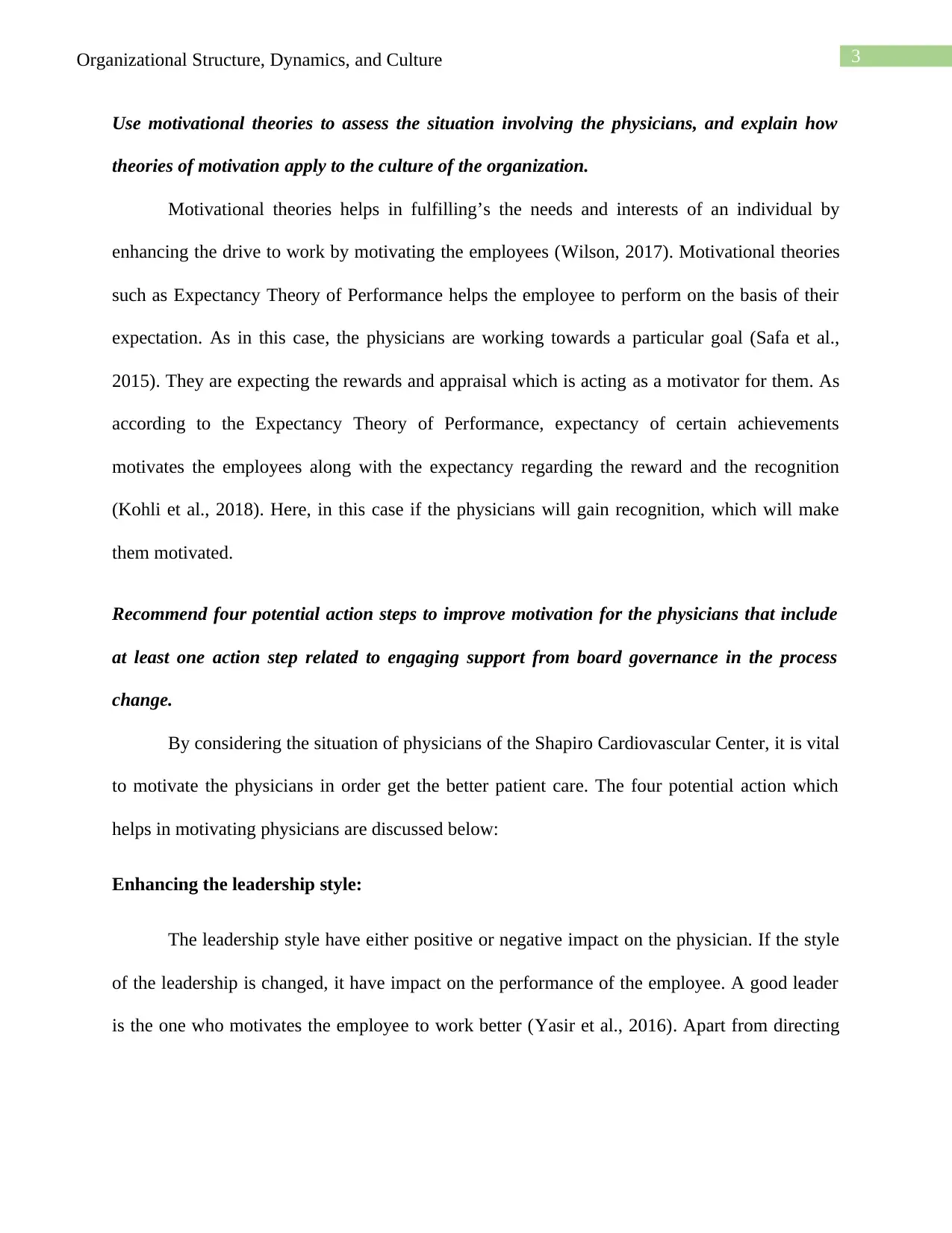
3Organizational Structure, Dynamics, and Culture
Use motivational theories to assess the situation involving the physicians, and explain how
theories of motivation apply to the culture of the organization.
Motivational theories helps in fulfilling’s the needs and interests of an individual by
enhancing the drive to work by motivating the employees (Wilson, 2017). Motivational theories
such as Expectancy Theory of Performance helps the employee to perform on the basis of their
expectation. As in this case, the physicians are working towards a particular goal (Safa et al.,
2015). They are expecting the rewards and appraisal which is acting as a motivator for them. As
according to the Expectancy Theory of Performance, expectancy of certain achievements
motivates the employees along with the expectancy regarding the reward and the recognition
(Kohli et al., 2018). Here, in this case if the physicians will gain recognition, which will make
them motivated.
Recommend four potential action steps to improve motivation for the physicians that include
at least one action step related to engaging support from board governance in the process
change.
By considering the situation of physicians of the Shapiro Cardiovascular Center, it is vital
to motivate the physicians in order get the better patient care. The four potential action which
helps in motivating physicians are discussed below:
Enhancing the leadership style:
The leadership style have either positive or negative impact on the physician. If the style
of the leadership is changed, it have impact on the performance of the employee. A good leader
is the one who motivates the employee to work better (Yasir et al., 2016). Apart from directing
Use motivational theories to assess the situation involving the physicians, and explain how
theories of motivation apply to the culture of the organization.
Motivational theories helps in fulfilling’s the needs and interests of an individual by
enhancing the drive to work by motivating the employees (Wilson, 2017). Motivational theories
such as Expectancy Theory of Performance helps the employee to perform on the basis of their
expectation. As in this case, the physicians are working towards a particular goal (Safa et al.,
2015). They are expecting the rewards and appraisal which is acting as a motivator for them. As
according to the Expectancy Theory of Performance, expectancy of certain achievements
motivates the employees along with the expectancy regarding the reward and the recognition
(Kohli et al., 2018). Here, in this case if the physicians will gain recognition, which will make
them motivated.
Recommend four potential action steps to improve motivation for the physicians that include
at least one action step related to engaging support from board governance in the process
change.
By considering the situation of physicians of the Shapiro Cardiovascular Center, it is vital
to motivate the physicians in order get the better patient care. The four potential action which
helps in motivating physicians are discussed below:
Enhancing the leadership style:
The leadership style have either positive or negative impact on the physician. If the style
of the leadership is changed, it have impact on the performance of the employee. A good leader
is the one who motivates the employee to work better (Yasir et al., 2016). Apart from directing
Paraphrase This Document
Need a fresh take? Get an instant paraphrase of this document with our AI Paraphraser
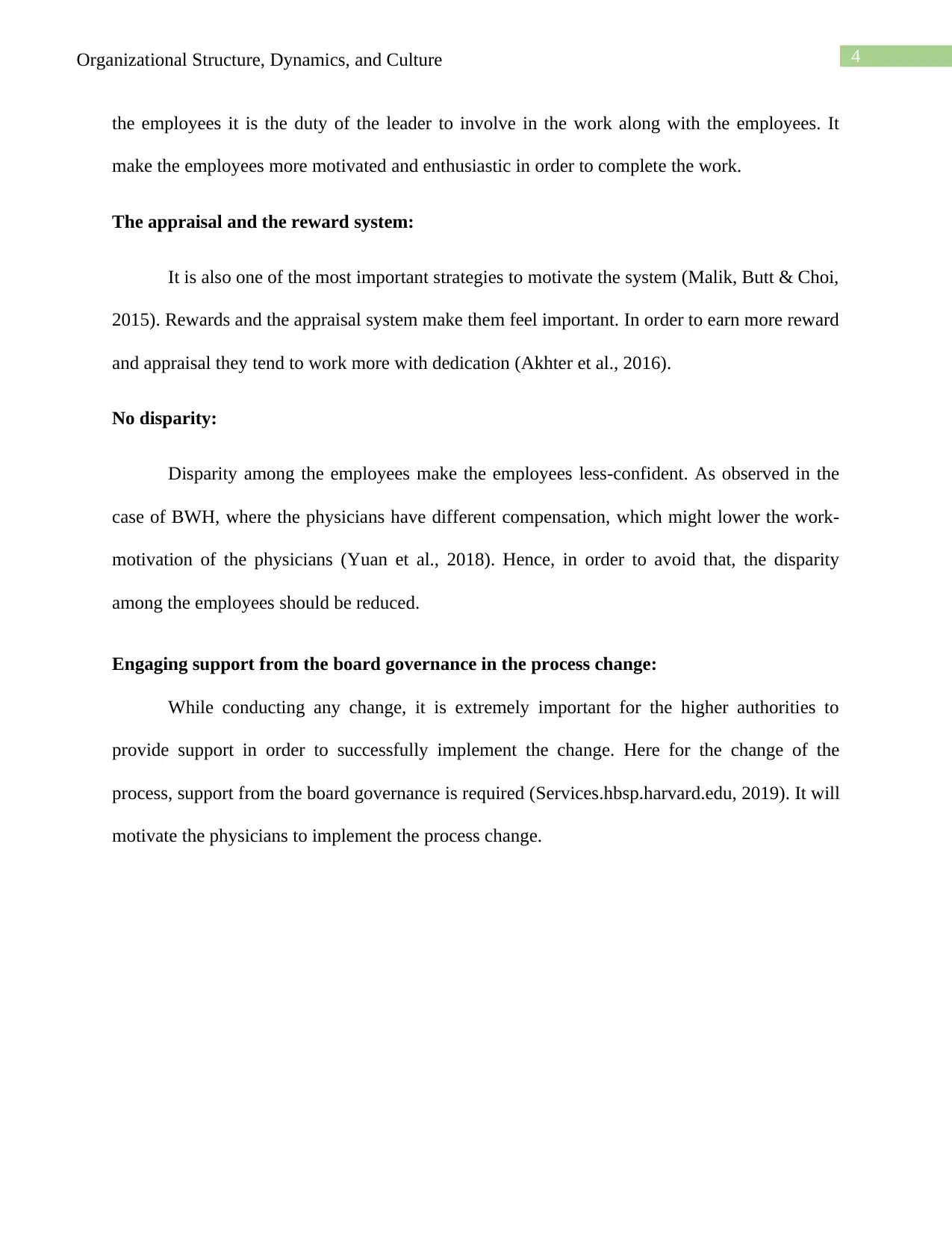
4Organizational Structure, Dynamics, and Culture
the employees it is the duty of the leader to involve in the work along with the employees. It
make the employees more motivated and enthusiastic in order to complete the work.
The appraisal and the reward system:
It is also one of the most important strategies to motivate the system (Malik, Butt & Choi,
2015). Rewards and the appraisal system make them feel important. In order to earn more reward
and appraisal they tend to work more with dedication (Akhter et al., 2016).
No disparity:
Disparity among the employees make the employees less-confident. As observed in the
case of BWH, where the physicians have different compensation, which might lower the work-
motivation of the physicians (Yuan et al., 2018). Hence, in order to avoid that, the disparity
among the employees should be reduced.
Engaging support from the board governance in the process change:
While conducting any change, it is extremely important for the higher authorities to
provide support in order to successfully implement the change. Here for the change of the
process, support from the board governance is required (Services.hbsp.harvard.edu, 2019). It will
motivate the physicians to implement the process change.
the employees it is the duty of the leader to involve in the work along with the employees. It
make the employees more motivated and enthusiastic in order to complete the work.
The appraisal and the reward system:
It is also one of the most important strategies to motivate the system (Malik, Butt & Choi,
2015). Rewards and the appraisal system make them feel important. In order to earn more reward
and appraisal they tend to work more with dedication (Akhter et al., 2016).
No disparity:
Disparity among the employees make the employees less-confident. As observed in the
case of BWH, where the physicians have different compensation, which might lower the work-
motivation of the physicians (Yuan et al., 2018). Hence, in order to avoid that, the disparity
among the employees should be reduced.
Engaging support from the board governance in the process change:
While conducting any change, it is extremely important for the higher authorities to
provide support in order to successfully implement the change. Here for the change of the
process, support from the board governance is required (Services.hbsp.harvard.edu, 2019). It will
motivate the physicians to implement the process change.
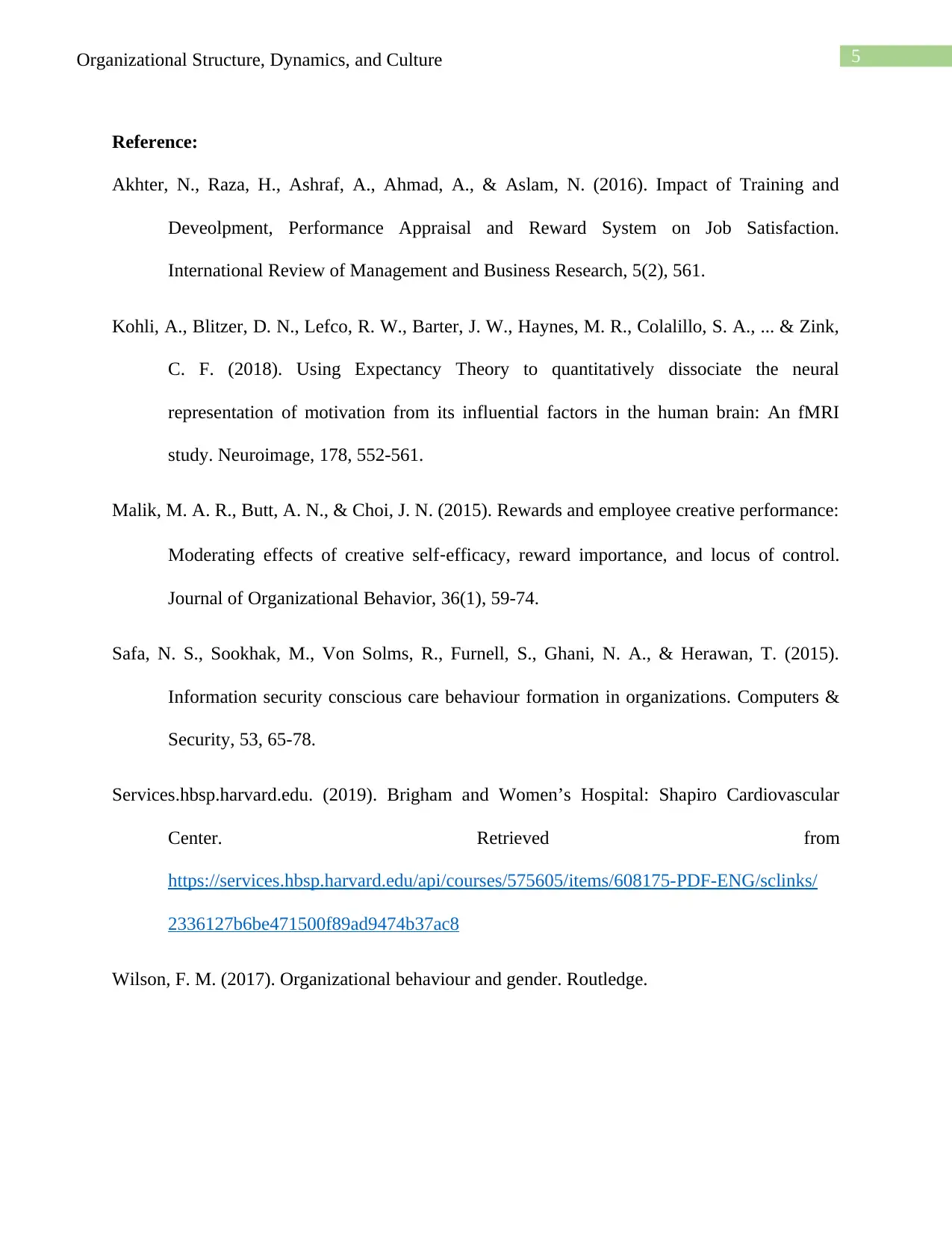
5Organizational Structure, Dynamics, and Culture
Reference:
Akhter, N., Raza, H., Ashraf, A., Ahmad, A., & Aslam, N. (2016). Impact of Training and
Deveolpment, Performance Appraisal and Reward System on Job Satisfaction.
International Review of Management and Business Research, 5(2), 561.
Kohli, A., Blitzer, D. N., Lefco, R. W., Barter, J. W., Haynes, M. R., Colalillo, S. A., ... & Zink,
C. F. (2018). Using Expectancy Theory to quantitatively dissociate the neural
representation of motivation from its influential factors in the human brain: An fMRI
study. Neuroimage, 178, 552-561.
Malik, M. A. R., Butt, A. N., & Choi, J. N. (2015). Rewards and employee creative performance:
Moderating effects of creative self‐efficacy, reward importance, and locus of control.
Journal of Organizational Behavior, 36(1), 59-74.
Safa, N. S., Sookhak, M., Von Solms, R., Furnell, S., Ghani, N. A., & Herawan, T. (2015).
Information security conscious care behaviour formation in organizations. Computers &
Security, 53, 65-78.
Services.hbsp.harvard.edu. (2019). Brigham and Women’s Hospital: Shapiro Cardiovascular
Center. Retrieved from
https://services.hbsp.harvard.edu/api/courses/575605/items/608175-PDF-ENG/sclinks/
2336127b6be471500f89ad9474b37ac8
Wilson, F. M. (2017). Organizational behaviour and gender. Routledge.
Reference:
Akhter, N., Raza, H., Ashraf, A., Ahmad, A., & Aslam, N. (2016). Impact of Training and
Deveolpment, Performance Appraisal and Reward System on Job Satisfaction.
International Review of Management and Business Research, 5(2), 561.
Kohli, A., Blitzer, D. N., Lefco, R. W., Barter, J. W., Haynes, M. R., Colalillo, S. A., ... & Zink,
C. F. (2018). Using Expectancy Theory to quantitatively dissociate the neural
representation of motivation from its influential factors in the human brain: An fMRI
study. Neuroimage, 178, 552-561.
Malik, M. A. R., Butt, A. N., & Choi, J. N. (2015). Rewards and employee creative performance:
Moderating effects of creative self‐efficacy, reward importance, and locus of control.
Journal of Organizational Behavior, 36(1), 59-74.
Safa, N. S., Sookhak, M., Von Solms, R., Furnell, S., Ghani, N. A., & Herawan, T. (2015).
Information security conscious care behaviour formation in organizations. Computers &
Security, 53, 65-78.
Services.hbsp.harvard.edu. (2019). Brigham and Women’s Hospital: Shapiro Cardiovascular
Center. Retrieved from
https://services.hbsp.harvard.edu/api/courses/575605/items/608175-PDF-ENG/sclinks/
2336127b6be471500f89ad9474b37ac8
Wilson, F. M. (2017). Organizational behaviour and gender. Routledge.
⊘ This is a preview!⊘
Do you want full access?
Subscribe today to unlock all pages.

Trusted by 1+ million students worldwide
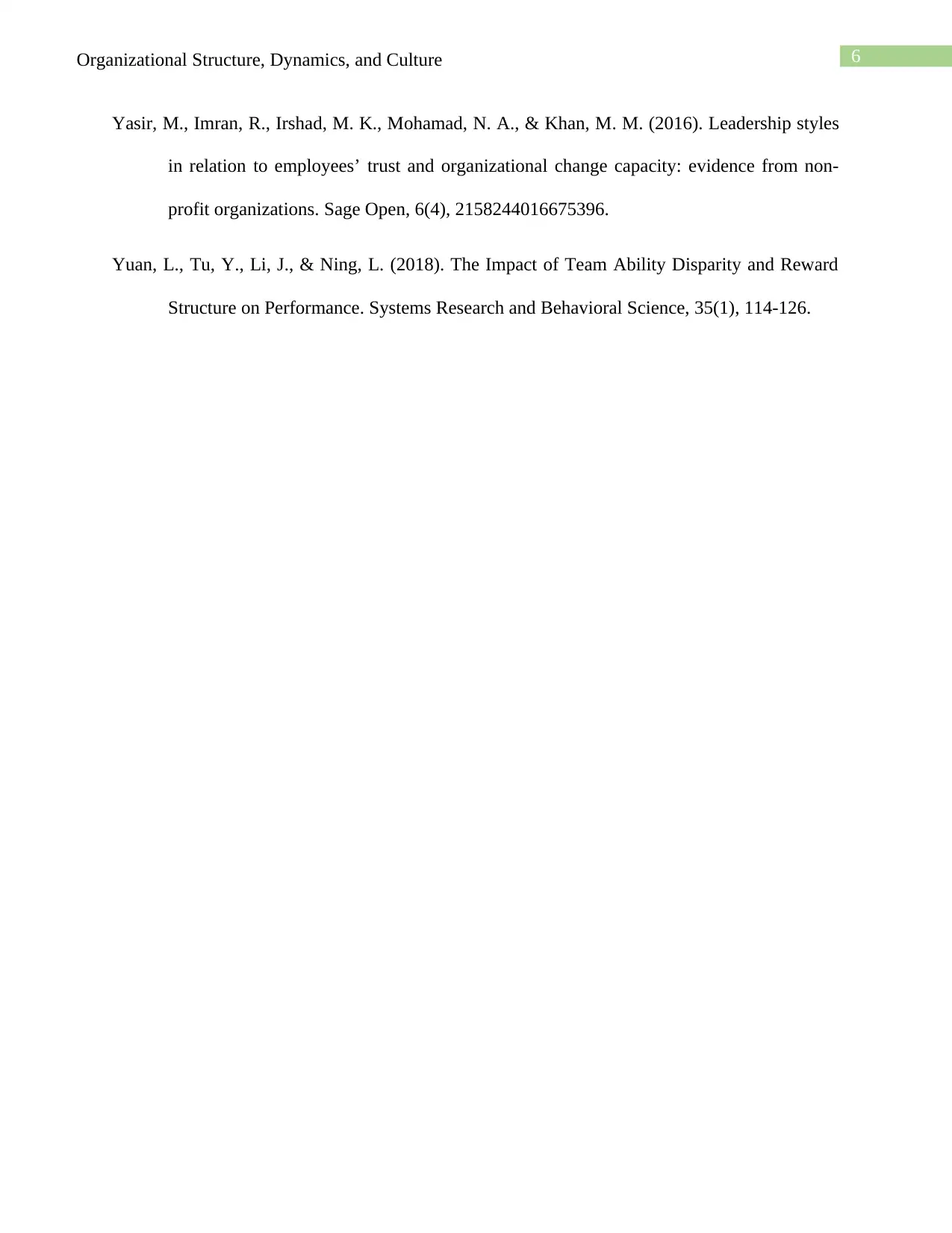
6Organizational Structure, Dynamics, and Culture
Yasir, M., Imran, R., Irshad, M. K., Mohamad, N. A., & Khan, M. M. (2016). Leadership styles
in relation to employees’ trust and organizational change capacity: evidence from non-
profit organizations. Sage Open, 6(4), 2158244016675396.
Yuan, L., Tu, Y., Li, J., & Ning, L. (2018). The Impact of Team Ability Disparity and Reward
Structure on Performance. Systems Research and Behavioral Science, 35(1), 114-126.
Yasir, M., Imran, R., Irshad, M. K., Mohamad, N. A., & Khan, M. M. (2016). Leadership styles
in relation to employees’ trust and organizational change capacity: evidence from non-
profit organizations. Sage Open, 6(4), 2158244016675396.
Yuan, L., Tu, Y., Li, J., & Ning, L. (2018). The Impact of Team Ability Disparity and Reward
Structure on Performance. Systems Research and Behavioral Science, 35(1), 114-126.
1 out of 7
Related Documents
Your All-in-One AI-Powered Toolkit for Academic Success.
+13062052269
info@desklib.com
Available 24*7 on WhatsApp / Email
![[object Object]](/_next/static/media/star-bottom.7253800d.svg)
Unlock your academic potential
Copyright © 2020–2025 A2Z Services. All Rights Reserved. Developed and managed by ZUCOL.




